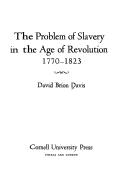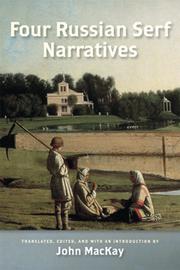| Listing 1 - 10 of 593 | << page >> |
Sort by
|

ISBN: 0801408881 9780801408885 Year: 1975 Publisher: Ithaca London Cornell University Press
Abstract | Keywords | Export | Availability | Bookmark
 Loading...
Loading...Choose an application
- Reference Manager
- EndNote
- RefWorks (Direct export to RefWorks)
Antislavery --- Esclavage --- Mui tsai --- Ownership of slaves --- Servitude --- Slave keeping --- Slavernij --- Slavery

ISBN: 0299233731 9780299233730 029923374X 9780299233747 9780299233747 Year: 2009 Publisher: Madison, Wis. University of Wisconsin Press
Abstract | Keywords | Export | Availability | Bookmark
 Loading...
Loading...Choose an application
- Reference Manager
- EndNote
- RefWorks (Direct export to RefWorks)
Although millions of Russians lived as serfs until the middle of the nineteenth century, little is known about their lives. Identifying and documenting the conditions of Russian serfs has proven difficult because the Russian state discouraged literacy among the serfs and censored public expressions of dissent. To date scholars have identified only twenty known Russian serf narratives. Four Russian Serf Narratives contains four of these accounts and is the first translated collection of autobiographies by serfs. Scholar and translator John MacKay brings to light for an English-language audience a diverse sampling of Russian serf narratives, ranging from an autobiographical poem to stories of adventure and escape. "Autobiography" (1785) recounts a highly educated serf's attempt to escape to Europe, where he hoped to study architecture. The long testimonial poem "News About Russia" (ca. 1849) laments the conditions under which the author and his fellow serfs lived. In "The Story of My Life and Wanderings" (1881) a serf tradesman tells of his attempt to simultaneously escape serfdom and captivity from Chechen mountaineers. The fragmentary "Notes of a Serf Woman" (1911) testifies to the harshness of peasant life with extraordinary acuity and descriptive power. These accounts offer readers a glimpse, from the point of view of the serfs themselves, into the realities of one of the largest systems of unfree labor in history. The volume also allows comparison with slave narratives produced in the United States and elsewhere, adding an important dimension to knowledge of the institution of slavery and the experience of enslavement in modern times.
Serfdom --- Serfs --- Servitude --- Forced labor --- Land tenure --- Slavery --- Villeinage --- History --- Law and legislation --- Persons
Book
ISBN: 9781526122254 1526122251 9781526122247 1526122243 152612226X 9781526122261 152613618X Year: 2018 Publisher: Manchester
Abstract | Keywords | Export | Availability | Bookmark
 Loading...
Loading...Choose an application
- Reference Manager
- EndNote
- RefWorks (Direct export to RefWorks)
Based on little-examined printed and archival sources, this text explores the fundamental ideas behind early French thinking about Atlantic slavery, c. 1620-1750. It analyses the three central questions of what made one a slave, of what was unique about Caribbean labour, and the implications of strategic approaches in interacting with slaves.
Esclavage --- Histoire. --- Dans la litterature. --- Atlantic. --- Caribbean. --- Colonisation. --- Early modern. --- France. --- Religion. --- Servitude. --- Slavery. --- Sugar. --- Travel.

ISBN: 2249291020 9782249291029 Year: 1984 Volume: 2 Publisher: Paris
Abstract | Keywords | Export | Availability | Bookmark
 Loading...
Loading...Choose an application
- Reference Manager
- EndNote
- RefWorks (Direct export to RefWorks)
World history --- Serfdom --- Servage --- History --- Histoire --- -Serfdom --- Servitude --- Forced labor --- Land tenure --- Slavery --- Villeinage --- Law and legislation --- -History --- Serfdom - History
Book
ISBN: 9780230004603 0230004601 Year: 2012 Volume: *15 Publisher: Basingstoke : Palgrave Macmillan,
Abstract | Keywords | Export | Availability | Bookmark
 Loading...
Loading...Choose an application
- Reference Manager
- EndNote
- RefWorks (Direct export to RefWorks)
"This new study provides an up-to-date survey of social and economic developments in early modern Eastern European rural societies. Markus Cerman revises the traditional images of mighty lords and poor, powerless 'serf peasants', discussing the theories which led to the assumption that serfdom existed throughout the region. Cerman contrasts the interpretation of a long-term backwardness with a fresh view of the legal, social and economic status of villagers, their living standards and their role in actively shaping rural communities. Featuring helpful tables, a glossary and a comprehensive bibliography, this is a stimulating reassessment for anyone studying this period and often neglected topic in European history."--Publisher's website.
Serfdom --- Europe, Eastern --- Economic conditions. --- Social conditions. --- Civilization. --- Servitude --- Forced labor --- Land tenure --- Slavery --- Villeinage --- Law and legislation
Book
ISBN: 152612582X 9781526125828 9781526125842 1526125846 1526125838 9781526125835 Year: 2021 Publisher: Manchester [UK]
Abstract | Keywords | Export | Availability | Bookmark
 Loading...
Loading...Choose an application
- Reference Manager
- EndNote
- RefWorks (Direct export to RefWorks)
This book explores the intimate relationship between literature and class in England (and later Britain) from the Peasants' Revolt at the end of the fourteenth century to the impact of the French Revolution at the end of the eighteenth century and beginning of the nineteenth. The book argues throughout that class cannot be seen as a modern phenomenon that occurred after the Industrial revolution but that class divisions and relations have always structured societies and that it makes sense to assume a historical continuity. The book explores a number of themes relating to class: class consciousness; class conflict; commercialisation; servitude; rebellion; gender relations; and colonisation. After outlining the history of class relations, five chapters explore the ways in which social class consciously and unconsciously influenced a series of writers: Chaucer, Shakespeare, Behn, Rochester, Defoe, Duck, Richardson, Burney, Blake and Wordsworth.
Social classes in literature. --- Class conflict. --- Class consciousness. --- Class. --- commerce. --- common. --- literature. --- rebellion. --- representation. --- servitude. --- social mobility.
Book
ISBN: 1306011345 1613742258 9781613742259 9781569766866 156976686X Year: 2002 Publisher: Chicago Chicago Review Press
Abstract | Keywords | Export | Availability | Bookmark
 Loading...
Loading...Choose an application
- Reference Manager
- EndNote
- RefWorks (Direct export to RefWorks)
African Americans --- Murder --- Peonage --- Plantation workers --- Trials (Murder) --- Murder trials --- Agricultural laborers --- Bonded labor --- Debt, Servitude for --- Debt bondage --- Debt slavery --- Servitude --- Servitude for debt --- Contract labor --- Forced labor --- Criminal homicide --- Killing (Murder) --- Homicide --- Afro-Americans --- Black Americans --- Colored people (United States) --- Negroes --- Africans --- Ethnology --- Blacks --- Crimes against --- Manning, Clyde. --- Williams, John S. --- Black people
Book
ISBN: 110859459X 1108687482 1108482414 110859560X 1108712274 Year: 2019 Publisher: Cambridge : Cambridge University Press,
Abstract | Keywords | Export | Availability | Bookmark
 Loading...
Loading...Choose an application
- Reference Manager
- EndNote
- RefWorks (Direct export to RefWorks)
Jan Breman takes dispossession as his central theme in this ambitious analysis of labour bondage in India's changing political economy from 1962 to 2017. When, in a remote past, tribal and low-caste communities were attached to landowning households, their lack of freedom was framed as subsistence-oriented dependency. Breman argues that with colonial rule came the intrusion of capitalism into India's agrarian economy, leading to a decline in the idea of patronage in the relationship between bonded labour and landowner. Instead, servitude was reshaped as indebtedness. As labour became transformed into a commodity, peasant workers were increasingly pushed out of agriculture and the village but remained adrift in the wider economy. This footloose workforce is subjected to exploitation when their labour power is required and is left in a state of exclusion when it is surplus to demand. The outcome is progressive inequality that is thoroughly capitalist in nature.
Peonage --- Labor policy --- Working poor --- Capitalism --- Market economy --- Economics --- Profit --- Capital --- Poor --- Working class --- Labor --- State and labor --- Economic policy --- Bonded labor --- Debt, Servitude for --- Debt bondage --- Debt slavery --- Servitude --- Servitude for debt --- Contract labor --- Forced labor --- History. --- Employment --- Government policy
Book
ISBN: 8175967463 8175968869 9788175968868 9788175967465 Year: 2011 Publisher: New Delhi Foundation Books
Abstract | Keywords | Export | Availability | Bookmark
 Loading...
Loading...Choose an application
- Reference Manager
- EndNote
- RefWorks (Direct export to RefWorks)
Human Rights and Law: Bonded Labour in India deals with the problem of debt bondage and the way it has been treated during the British as well as in the post-independence period. Analysis has been made of the motivations for carrying out the reform; the processes involved in formulating the legislation, contributions by different agencies, discussion in the parliament, etc. The two legislations: the Indian Slavery Act, 1843 and bonded labour system (Abolition) Act, 1976 provide a comparative perspective in the making of social legislation in two different historical settings and different political systems.
Forced labor --- Human rights --- Peonage --- Law - Non-U.S. --- Law, Politics & Government --- Law - Africa, Asia, Pacific & Antarctica --- Basic rights --- Civil rights (International law) --- Rights, Human --- Rights of man --- Human security --- Transitional justice --- Truth commissions --- Compulsory labor --- Conscript labor --- Labor, Compulsory --- Labor, Forced --- Employees --- Bonded labor --- Debt, Servitude for --- Debt bondage --- Debt slavery --- Servitude --- Servitude for debt --- Contract labor --- Law and legislation --- History. --- History --- E-books
Book
ISBN: 9783839437339 3839437334 3837637336 9783837637335 Year: 2016 Publisher: Bielefeld, Germany transcript Verlag
Abstract | Keywords | Export | Availability | Bookmark
 Loading...
Loading...Choose an application
- Reference Manager
- EndNote
- RefWorks (Direct export to RefWorks)
Parallel to the abolition of Atlantic slavery, new forms of indentured labour stilled global capitalism's need for cheap, disposable labour. The famous 'coolie trade' - mainly Asian labourers transferred to French and British islands in the Indian Ocean, Australia, Indonesia, South Africa, the Caribbean, the Americas, as well as to Portuguese colonies in Africa - was one of the largest migration movements in global history. Indentured contract workers are perhaps the most revealing example of bonded labour in the grey area between the poles of chattel slavery and 'free' wage labour. This interdisciplinary volume addresses historically and regionally specific cases of bonded labour relations from the 18th century to sponsorship systems in the Arab Gulf States today. »Dies ist ein wichtiges Buch, nicht nur für Migrationsforscher und Wirtschaftshistoriker, sondern für alle, die sich mit ökonomischen, sozialen und politischen Zusammenhängen im Kontext einer aktuellen Kapitalismusforschung auseinandersetzen. Das Buch wird nachdrücklich empfohlen.« Hermann Mückler, Mitteilungen der Anthropologischen Gesellschaft in Wien, 147 (2017)
E-books --- Peonage --- Forced labor --- Slave labor --- Labor contract --- Labor policy --- Indentured servants --- History --- Forced labor. --- Compulsory labor --- Conscript labor --- Labor, Compulsory --- Labor, Forced --- Employees --- Colonialism. --- Culture. --- Ethnology. --- Global History. --- Globalization. --- History of Colonialism. --- History. --- Migration. --- Postcolonialism. --- Social History. --- Work. --- Labour; Colonialism; Migration; History; Culture; Globalization; Postcolonialism; Work; Global History; History of Colonialism; Social History; Ethnology --- Bonded labor --- Debt, Servitude for --- Debt bondage --- Debt slavery --- Servitude --- Servitude for debt --- Contract labor
| Listing 1 - 10 of 593 | << page >> |
Sort by
|

 Search
Search Feedback
Feedback About UniCat
About UniCat  Help
Help News
News